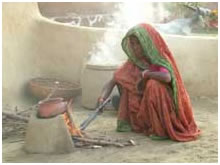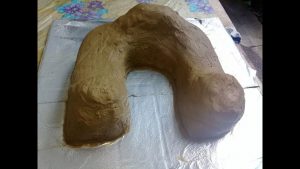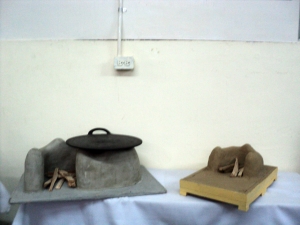1. Benefits of cooking on a chulha
A. The regular process of cooking on a chulha purifies the place and enhances the Sattva component in that place. This makes that place more sattvik and pure.
B. The food cooked on a chulha is least affected by the attacks of negative energies.
C. A protective sheath is created around the food and the utensils used in cooking when the food is cooked on a chulha. The burning of wood and its fire attracts inferior Deity Principle and some positive energies in that environment.
D. According to the bhav of the individual who prepares the food, superior Deities become active in the area. This also helps others who are involved in cooking. The individual who is involved in cooking gets the benefit of sattvik environment that enhances his Sattva component and bestows the individual with peace as well as provides him with spiritual benefit.
E. When food is cooked on a chulha, a Sattva-predominant environment is created there. Therefore, any individual who enters there gets the benefit of that environment. Since the environment undergoes constant purification due to the chulha, the distress due to negative energies is less when compared with other places. Therefore, one feels calm and stable there. This also helps the individual who moves around there to remain in a pleasant mood.
F. Spiritual experience – Vision of food being cooked on a chulha in the subtle and blue waves entering the food from the lit fire : On 26.6.2009, I had a vision that food was being cooked on a chulha in the subtle and blue waves were entering the food from the lit fire. The waves were spreading in the entire room and then into the environment.
2. Benefits to the individual who cooks food on the chulha
A. I perceived that the smoke emanating from the chulha while cooking food was spreading into the environment. The fragrance of the smoke entered the body of the individual through his breath while cooking food. A point of white light was created at the Swadhishṭhan-chakra of the individual.
B. The point of light later gave rise to a larger light that spread to the backbone of that individual and then extended to his entire head. As a result, white spherical rings were seen revolving over the head and back.
C. I also perceived that this process purified the subtle-bodies of the individual.
3. Benefits of consuming the food cooked on a chulha
A. The food cooked on a chulha attracts God Principle to a greater extent, thus enhancing the Sattva component in the individual who eats it. As a result, he obtains physical as well as psychological benefits from the health perspective.
B. Since the food cooked on a chulha comes in contact with Divine qualities, it becomes tastier. Therefore, it satisfies the individual who eats it.
– Mrs Ranjana Gautam Gadekar, Ramnathi, Goa.
4. In Udupi (Karnataka, Bharat), food is cooked only on chulhas
‘In Udupi, food is cooked in a traditional manner in the kitchens. Cooking for a large number of people is done on chulhas without using electricity or LPG cylinders.’ – Mr Abhijeet Kharat
5. Why should live coals not be immediately extinguished with water ?
‘The fire in live coals represents the Shiva Principle, while the Adi-shakti (Divine Energy) Principle in the form of Annapurnadevi is active as the energy needed for cooking. Thus, fire in the Shiva form as well as Annapurnadevi in energy form work together to convert food into food containing the God Principle. Immediate extinguishing of live coals with water after the process of cooking amounts to destroying the manifest waves of Agnitattva (Absolute Fire Principle). Therefore, instead of doing so, one should offer Naivedya to the waves of Agnitattva and Annapurnadevi, praying to them to calm down, and then sprinkle a little water on the live coals. The fire calms down even with the slight sprinkling of water after praying.’
Credits to – https://www.hindujagruti.org/hinduism/hindu-lifestyle/cooking/mud-chulha
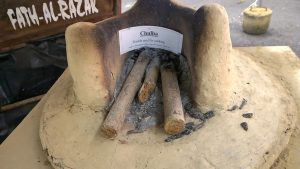
The challenge of the chulha
About 24 years ago, I was in a house in a small village some distance from Udaipur town in Rajasthan. A government functionary was explaining how an improved chulha (cookstove) worked– they had installed it in the kitchen. At that time, India was waking up to forests being devastated. It was believed then (wrongly, as it turned out) the key reason was poor people cutting trees to cook food. It was also being understood smoke from chulhas was carcinogenic and that women were worst hit by this pollution. The answer was to design improved chulhas–for better combustion and with a chimney.
The woman owner of this improved stove was cooking the day’s meal. I asked if she was happy with what science and government had donated to her. Her answer was simple: “Looks good, does not work. I modified it.” Her problem was that, in this area, women cooked gruel on big utensils. Her home-made original stove was fitted to her diet and her utensils. The improved chulha, with its small opening to streamline the fire, was of little use. When the chulha was designed, nobody asked her what she needed. Nobody explained to her the laws of thermodynamics, so that she could fathom why the stove looked and worked as it did. And nobody was there who could repair or reshape her cookstove. She had simply broken the opening to fit her needs. Carefully calculated combustion in the laboratory of the local university and delivered through a government programme had turned to hot air.
I learnt my most valuable lesson that day. Designing technologies for diversity and affordability is much more complex than sending a man to the moon.
Consider the government’s own statistics. By 1994, some 15 million improved chulhas were introduced across the country. A survey by the National Council of Applied Economic Research found, in many cases, the stoves were not appropriately designed or had broken with use; over 62 per cent of the respondents said they did not know who to contact for repairs. No surprise here. Technology deployment in poor and unserviced households is a job the market does badly.
But why am I discussing this moment of development history? Well, cookstoves are back. This time, on the world stage. Science has discovered black carbon–soot–is a key contributor to climate change; these particles warm the air; when they settle on glaciers, the latter melt. So now, soot from chulhas poor households use–burning wood, twigs and cowdung–stands indicted for climate change. A bill has been introduced in the US Congress requiring the country’s environment protection agency to regulate black carbon and direct aid to black carbon reduction projects abroad, including introducing chulhas in some 20 million homes.
I don’t dispute the science of black carbon. There is no reason to argue nothing should be done to improve and substitute the polluting and noxious chulhas of the poorest. The problem is not in the intent. The problem is in the ‘why’ and the ‘what needs to be done’. Today, the international community sees these chulhas as an easy solution: 18 per cent of the problem comes from these implements, so replace them. Here’s a quick and simple climate fix: creating space for cars and power stations to continue to pollute. Also, the international community is today equating this ‘survival’ emission–of poor people with no alternative but to walk long distances to collect firewood, sweep the forest floor for leaves and twigs and do backbreaking work to collect and dry cow-dung, all for some ‘oil’ to cook their food–with the ‘luxury’ emissions of you and I, who drive to work and live in air-conditioned comfort.
This distinction is necessary. For policy and action. Otherwise, an important opportunity–provided to us by the poorest in the world–to reduce emissions in the future will be lost. Lost, once again, to the ignorance of the international community regarding how the other half lives and the arrogance of powerful polluters. Let us be clear: the poorest of the world, who use polluting chulhas because they cannot afford commercial fossil fuel, provide us the only real space today to avert climate change.
According to 2006 International Energy Agency data, roughly 13 per cent of the world’s primary energy supply can be classified as ‘renewable’. Of this, new renewables–solar, wind, geothermal and cogeneration–make up just about 4 per cent and hydroelectricity 16 per cent. The bulk–80 per cent–of what is renewable comes from biomass burning, from the very chulhas of poor families. It is these families, living on the margins of survival, already vulnerable to climate change impacts, that are in the renewable energy net. They are not the problem. They are the solution to our excesses.
The energy trajectory is such that these families, when they move out of poverty, will also move out of cooking on this biomass stove. They will walk up the fossil fuel stairway to liquid petroleum gas (lpg). Every time they move away, as they must, one less family will be using renewable energy; one more, like you and me, will begin polluting with long-life greenhouse gas emissions. The difference is black soot pollutes locally–it literally kills the women who cook–but has a relatively short life in the atmosphere. So, unlike carbon dioxide, it disappears in a few weeks.
The poorest, therefore, provide the world the perfect opportunity to leapfrog–they can move from using renewable energy, currently polluting, to using more renewable energy, but which is clean for them and the world. It is this objective that must drive our efforts, not a plan to pick on the poorest so we can continue to pollute.
This is not easy. It will not be cheap. Science now must invent that cheap, biomass-based chulha that can be sold, distributed and used in millions of diverse households across the world. Are we up to the challenge?
Credits to – https://www.downtoearth.org.in/blog/the-challenge-of-the-chulha-3386
Chulha is a traditional Indian cooking stove used for indoor cooking.
Chulha is a U-shaped mud stove made from local clay. After the clay formation is complete, it is finished by covering it with a coat of clay and cow dung mixture. The thickness of the walls is not as important as the dimensions of the fire-side are. The front of the chulha has an apron. This apron helps hold the fuel to be burnt (usually wood, sticks, cow dung patties, straw, crop waste etc). Once the process of cooking is complete the apron holds the ashes, which are removed later.
To cook on such traditional stoves, one must squat on one’s haunches or sit on the floor. Burning of cow dung is supposed to purify the stove. A mixture of clay and cow dung is routinely prepared to coat the cooking surface of the stoves
Food being prepared on a traditional Chulha
Fuel used: Wood and animal dung patties are used as fuel for the Chulha . Animal dung patties are called ‘Upla’or dung cakes. [The animal dung of domestic animals like cows, buffalos, goat, sheep, camels, etc is mixed with finely chopped plant materials (stalks called Sarkanda, straw called Tuhari). The mixture is formed into patties (about 6″ diameter and 1″ thick) and dried in the hot sun. The plant material depends on the region and the crop being harvested. In North India, mustard stalks, legume stalks, wheat straw are commonly used. The plant materials add to the density of Upla and makes the fire last longer like charcoal.
Disadvantage: The major problem with Chulha is that a lot of smoke is produced inside the house by burning wood, dung, and crop waste. The smoke may cause acute respiratory, ear, and eye infections. Smoke also causes breathlessness, chest discomfort, headaches and this can be fatal for children. In urban India, Chulhas are built under a chimney so the smoke rises naturally and escapes through the chimney. Newer designs are being tried to trap toxic particles by using filters etc.
The following is an article to show that the Chulha is a very important and essential item in the kitchens of the masses in India and an attempt to redesign such an iconic stove, to solve all its inherent problems is one of the social concerns of a design company Philips.
Indian Chulha
This simple stove promises to help reduce th 1.6 million fatalities associated each year with indoor cooking, 25 percent in India aloneIn Hindi the word “chulha” means stove, but for millions of low-income people in developing countries, a stove is a pile of stones heated by an open wood- or cow-dung-burning fire in their homes. This method of cooking poses a serious health hazard: indoor air pollution resulting from the burning of biomass fuels is a leading cause of respiratory diseases. In fact, the World Health Organization estimates that 1.6 million people — mostly women and children, who are more likely to cook or to be confined in the home while cooking is done — die annually from indoor air pollution; India alone accounts for 25 percent of such deaths. That’s why Philips’s Philanthropy by Design unit, working with the company’s Indian office and the organization ARTI (Appropriate Rural Technology Institute), chose for its first project to create a stove that wouldn’t taint the air. “The goal was a low-tech, low-cost, low-smoke device that respects local traditions and culinary habits,” says Simona Rocchi, senior director for sustainable design at Philips and a member of the core design team for the Chulha project, which won the 2009 INDEX Award in the Home category.
The Chulha is a simple, modular concrete-block stove covered in brown clay. It features two potholes: one for circulating hot air for steamed foods such as rice, and the other for heating flat pans holding chipati (fried bread) and similar dishes. The modular format was chosen to facilitate production, assembly, installation and the replacement of parts. As the design progressed, two models of the Chulha emerged to accommodate different income levels: one version priced at 9 to 11 Euros ($13.10 to $16) has a double oven and hotbox; a pricier model, at 13 to 15 Euros ($18.90 to $21.80), includes a steamer. Both stoves feature a decorative pattern common in India, which could be described in marketing terms as a lifestyle upgrade. After all, notes Rocchi, “Design solutions for poor people don’t have to be ugly.”
A critical design element of the Chulha is a chimney fitted with a special filtering device made of slotted clay tablets to trap toxic particles. Many stoves currently in use don’t have chimneys at all, and those that do are often cleaned from the domicile’s roof, an onerous and accident-prone task usually undertaken by women. The Chulha’s chimney is equipped with a small trap door that affords easier cleaning from within the house. Initial tests suggest that the Chulha reduces indoor air pollution by up to 90 percent compared with indoor open cooking-fires.
Another goal of the project is to enable local people and entrepreneurs — especially women-run enterprises — to produce and sell the Chulha, based on a special training kit and open-source manufacturing plans made available by Philips. An estimated 1,000 new stoves will be distributed over the next year in Pune, India, to test the product and its social impact, and a second pilot project will begin soon in Bangalore. Rocchi says reduced-smoke stoves could be applied in Bangladesh and Pakistan — countries that have culinary traditions similar to India’s, but substantial adaptations would be required to fit the particular cuisines and rounder house shapes (necessitating a different kind of chimney) of potential users in Latin America and Africa.
Unmesh Kulkarni and Praveeen Mareguddi from Philips Design team India were awarded the INDEX award for the home category in 2009 for their design of this Chulha.
Credits to -http://www.dsource.in/resource/kitchen-products/stoves/chulha
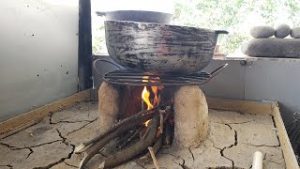
THE CHULHA (FIRESIDE)
The ‘chulha’ is an apparatus used for cooking. The first ‘chulhas’ was made from at least three pieces of rocks placed in a triangular position and raised to about eight or ten inches above ground. The pots were placed on the top of the ‘chulha’ while dried wood was used as fuel to ignite the fire.
For cooking large amounts of food, a dugout hole about twelve to eighteen inches was made in the ground.
Then in most homes we find the earthen ‘chulha’ that was neatly fashioned as seen in the picture. ‘Chulhas’ were often constructed in a very simple way to accommodate one pot at a time, or in a more complex form, often referred to as ‘Do-Aillah’, to accommodate two pots.
Credits to – http://www.icmtt.org/index.php/company/affiliates/item/94-the-fireside
Please consider Donating to keep our culture alive

